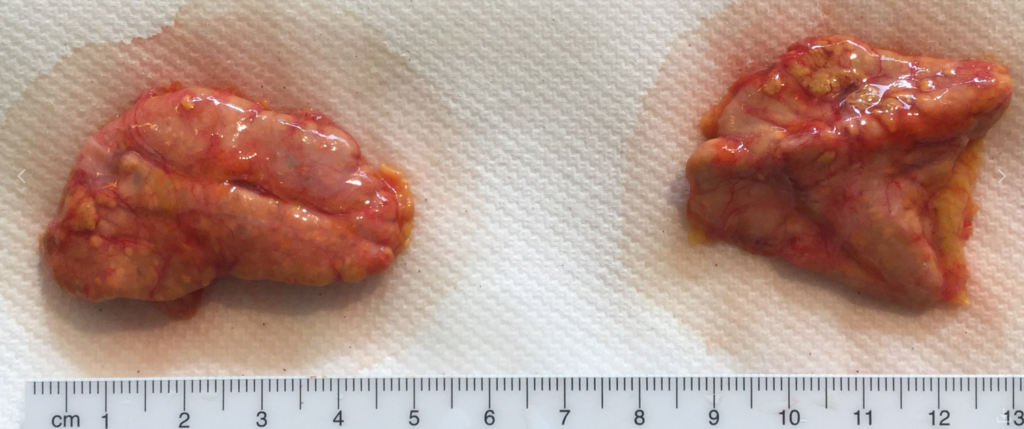The adrenal glands, also known as suprarenal glands, are small, triangular-shaped endocrine glands located on top of each kidney. They play a crucial role in producing hormones that regulate metabolism, immune response, blood pressure, stress response, and other vital functions.
Anatomy of the Adrenal Gland
1. Location and Structure:
Location: Each adrenal gland sits atop the corresponding kidney. The right adrenal gland is pyramid-shaped, while the left is more crescent-shaped.
Size and Shape: Each gland is approximately 3-5 cm in length, 2-3 cm in width, and 1 cm in thickness, weighing about 4-6 grams.
2. Anatomical Divisions:
Cortex: The outer region, responsible for producing steroid hormones.
Zona Glomerulosa: The outermost layer, producing mineralocorticoids (e.g., aldosterone).
Zona Fasciculata: The middle layer, producing glucocorticoids (e.g., cortisol).
Zona Reticularis: The innermost layer, producing androgens (e.g., dehydroepiandrosterone or DHEA).
Medulla: The inner region, producing catecholamines (e.g., adrenaline and noradrenaline).
Structure of the Adrenal Gland
1. Capsule: A fibrous capsule encases each adrenal gland, providing structural support and protection.

2. Adrenal Cortex:
Zona Glomerulosa: Composed of small, rounded clusters of cells. This layer primarily synthesizes and secretes aldosterone.
Zona Fasciculata: Composed of larger cells arranged in long columns. It produces glucocorticoids, mainly cortisol, which are crucial for stress response and metabolism.
Zona Reticularis: Contains cells arranged in a network. It produces androgens, which are precursors to sex hormones.

3. Adrenal Medulla: Composed of chromaffin cells, which produce catecholamines (adrenaline and noradrenaline) in response to stress. These cells are derived from neural crest cells and are considered part of the sympathetic nervous system.
Functions of the Adrenal Gland
1. Hormone Production:
Mineralocorticoids:
Aldosterone: Regulates sodium and potassium balance, thereby controlling blood pressure and fluid balance.
Glucocorticoids:
Cortisol: Regulates metabolism, immune response, and stress response. It increases blood sugar levels, suppresses the immune system, and aids in fat, protein, and carbohydrate metabolism.
Androgens:
DHEA and Androstenedione: Precursors to sex hormones like testosterone and estrogen. They contribute to the development of secondary sexual characteristics.
Catecholamines:
Adrenaline (Epinephrine) and Noradrenaline (Norepinephrine): Mediate the “fight or flight” response, increasing heart rate, blood pressure, and blood glucose levels.
2. Regulation of Metabolism:
Glucocorticoids: Increase gluconeogenesis, mobilize amino acids, and promote fat breakdown.
Catecholamines: Enhance metabolic rate and energy mobilization.
3. Stress Response:
The adrenal glands play a pivotal role in the body’s response to stress by releasing cortisol and adrenaline, which prepare the body to handle stressful situations.
4. Electrolyte Balance:
Aldosterone maintains sodium and potassium balance, which is crucial for normal cellular function and blood pressure regulation.
Disorders of the Adrenal Gland
1. Adrenal Insufficiency (Addison’s Disease):
A condition where the adrenal glands do not produce enough steroid hormones.
Causes: Autoimmune destruction, infections (e.g., tuberculosis), adrenal hemorrhage, genetic disorders.
Symptoms: Fatigue, muscle weakness, weight loss, low blood pressure, hyperpigmentation of the skin, salt craving.
Diagnosis: Low cortisol and aldosterone levels, high ACTH levels, ACTH stimulation test.
Treatment: Hormone replacement therapy (e.g., hydrocortisone, fludrocortisone).
2. Cushing’s Syndrome:
A condition characterized by excessive levels of cortisol.
Causes: Prolonged use of glucocorticoid medications, adrenal adenomas or carcinomas, ACTH-secreting pituitary tumors (Cushing’s disease).
Symptoms: Weight gain (especially in the abdomen and face), purple striae, muscle weakness, hypertension, osteoporosis, diabetes, mood changes.
Diagnosis: Elevated cortisol levels, dexamethasone suppression test, imaging studies.
Treatment: Surgical removal of tumors, reduction in glucocorticoid use, medications to inhibit cortisol production.
3. Congenital Adrenal Hyperplasia (CAH):
A group of genetic disorders affecting adrenal steroid biosynthesis, leading to cortisol deficiency and androgen excess.
Causes: Mutations in genes involved in steroidogenesis (e.g., 21-hydroxylase deficiency).
Symptoms: Ambiguous genitalia in newborns, early onset of puberty, rapid growth but short adult stature, salt-wasting crisis.
Diagnosis: Elevated 17-hydroxyprogesterone levels, genetic testing.
Treatment: Glucocorticoid and mineralocorticoid replacement therapy, salt supplements.
4. Pheochromocytoma:
A rare tumor of the adrenal medulla that produces excessive catecholamines.
Causes: Genetic mutations (e.g., MEN2, VHL syndromes).
Symptoms: Hypertension, palpitations, sweating, headaches, anxiety.
Diagnosis: Elevated catecholamines and metanephrines in blood and urine, imaging studies.
Treatment: Surgical removal of the tumor, alpha and beta-blockers to control blood pressure before surgery.
5. Primary Hyperaldosteronism (Conn’s Syndrome):
Overproduction of aldosterone by the adrenal glands.
Causes: Adrenal adenoma, bilateral adrenal hyperplasia.
Symptoms: Hypertension, hypokalemia, muscle cramps, weakness.
Diagnosis: Elevated aldosterone, low renin levels, aldosterone-renin ratio, adrenal vein sampling.
Treatment: Surgical removal of the adenoma, mineralocorticoid receptor antagonists (e.g., spironolactone).
Conclusion
The adrenal glands are vital endocrine organs with significant roles in hormone production, metabolism, stress response, and electrolyte balance. Disorders of the adrenal glands, such as adrenal insufficiency, Cushing’s syndrome, congenital adrenal hyperplasia, pheochromocytoma, and primary hyperaldosteronism, can lead to profound metabolic and physiological disturbances. Understanding the anatomy, structure, functions, and pathologies of the adrenal glands is essential for the diagnosis and management of these disorders.




 Why Choose Pharmaacademias? – Comprehensive Collection: Explore an extensive repository of previous year question papers […]
Why Choose Pharmaacademias? – Comprehensive Collection: Explore an extensive repository of previous year question papers […]